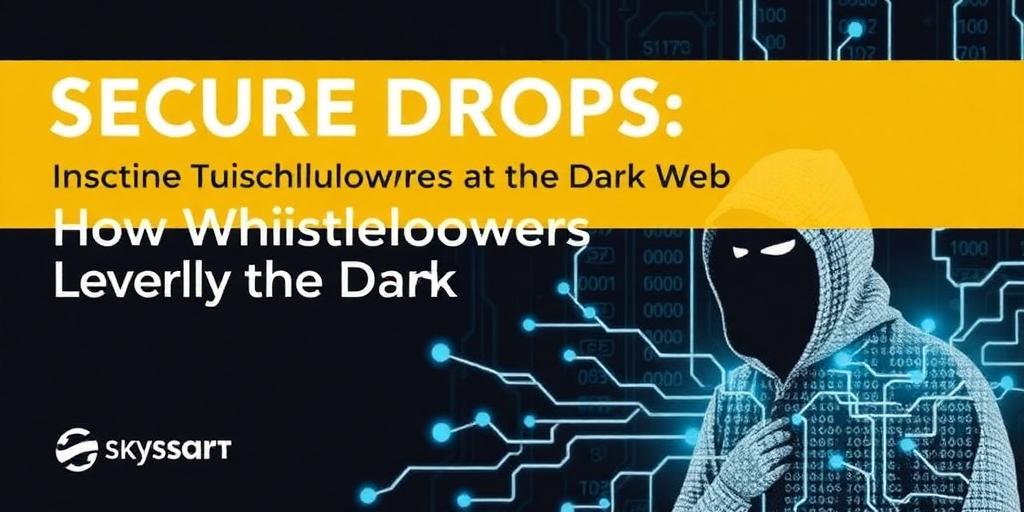Secure Drops: How Whistleblowers Leverage the Dark Web
In an era defined by digital surveillance and data breaches, the need for secure communication channels is more critical than ever. Whistleblowers, journalists, and activists often require methods to exchange sensitive information without exposing their identities or sources. One tool that has emerged as a crucial component in this landscape is the SecureDrop platform, often accessed via the Dark Web.
What is SecureDrop?
SecureDrop is an open-source whistleblower submission system that media organizations and NGOs use to securely receive documents from anonymous sources. Initially developed by the late Aaron Swartz and Kevin Poulsen, it is now maintained by the Freedom of the Press Foundation. SecureDrop aims to provide a safe, encrypted channel for sources to leak information to journalists, minimizing the risk of exposure.
Key Features and Functionality
- Anonymity: SecureDrop is designed to protect the anonymity of both the source and the recipient. It achieves this through several layers of security, including the use of Tor.
- Encryption: All communications and document transfers are encrypted, making it extremely difficult for third parties to intercept and read the data.
- Secure Infrastructure: SecureDrop utilizes a two-server architecture. One server handles the public-facing interface (accessed via Tor), and the other stores the submissions. This separation minimizes the risk of a single point of failure.
- Metadata Stripping: SecureDrop automatically strips metadata from uploaded documents, further reducing the risk of identification.
Accessing SecureDrop via the Dark Web
The Dark Web, a subset of the Deep Web, requires special software like the Tor browser to access. Tor routes internet traffic through multiple encrypted nodes, masking the user's IP address and location. This anonymity is vital for whistleblowers who face potential legal or professional repercussions.
To access a SecureDrop instance, a whistleblower must obtain the .onion address of the specific organization they wish to contact. This address leads to the organization's SecureDrop portal on the Tor network, where they can upload documents and communicate with journalists.
Why the Dark Web?
The Dark Web provides an additional layer of security that the regular internet cannot offer. Here’s why it’s so crucial for SecureDrop:
- Circumventing Censorship: In countries with strict internet censorship, the Dark Web allows individuals to bypass government firewalls and access blocked content.
- Protecting Identity: The Tor network masks the user’s IP address, making it difficult to trace the source of the communication. This is particularly important for whistleblowers who may face retaliation.
- Secure Communication: Encryption within the Tor network ensures that communications remain private and cannot be easily intercepted by third parties.
Challenges and Limitations
While SecureDrop offers significant security advantages, it is not without its challenges:
- Complexity: Setting up and using SecureDrop requires technical expertise. Misconfigurations can create vulnerabilities.
- Operational Security: Even with SecureDrop, users must follow strict operational security (OpSec) practices to avoid deanonymization. This includes using a dedicated, clean operating system (like Tails) and avoiding activities that could reveal their identity.
- Trust: Whistleblowers must trust the organization running the SecureDrop instance to maintain its security and protect their anonymity. Due diligence is essential.
Best Practices for Whistleblowers
- Use a Secure Operating System: Tails (The Amnesic Incognito Live System) is a Linux distribution designed for anonymity and privacy.
- Maintain OpSec: Avoid using personal devices or accounts when accessing SecureDrop. Be mindful of metadata and other identifying information.
- Verify .onion Addresses: Always double-check the .onion address of the SecureDrop instance to ensure you are connecting to the correct server.
- Encrypt Sensitive Information: Even within SecureDrop, encrypt sensitive documents using tools like GPG or VeraCrypt.
The Future of Secure Communication
As surveillance technologies continue to advance, the need for secure communication channels will only grow. Platforms like SecureDrop represent a critical tool for protecting whistleblowers and enabling the free flow of information. By leveraging the Dark Web, these systems provide a vital lifeline for those who seek to expose wrongdoing and hold power accountable.
SecureDrop and similar initiatives underscore the ongoing battle between privacy and surveillance in the digital age. As technology evolves, so too must the methods we use to protect our fundamental rights to freedom of speech and expression.









